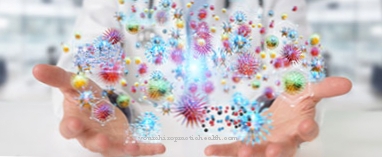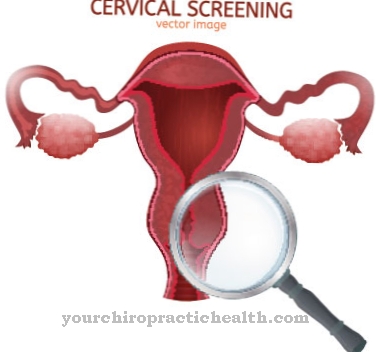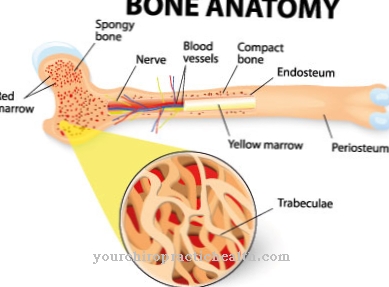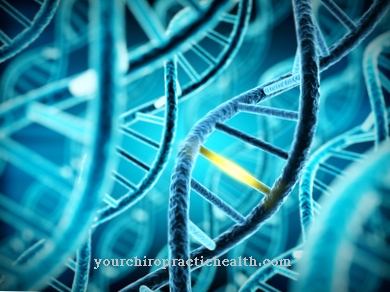Anal fistulas are pathologically altered ducts (fistulas) in the perianal area, which in most cases can be traced back to a proctodeal infection with abscess formation. Surgical intervention or splitting the fistula is the primary therapeutic measure for anal fistulas.
What are anal fistulas?

An anal fistula (also fistula ani) is a pathologically altered, tubular connection between the outer anal area (outer fistula opening) and the anal canal or rectum (inner fistula opening).
Anafistulas usually show inflammatory changes, which is why purulent secretion is emptied through the fistula canal, which may possibly be mixed with stool.
Depending on the anatomical location and its course, a distinction is made between intersphincteric (located between the two anal sphincters), extrasphinous (surrounding the sphincter apparatus), submucosal (located between the rectal mucosa and the internal anal sphincter), transsphere (crossing both anal sphincters), subcutaneous and suprasphere and pelvic floor muscles) differentiated anal fistulas.
causes
In most cases, anal fistulas can be traced back to smaller anal abscesses (collections of pus) in the area of the proctodeal glands around the internal sphincter or a direct infection of one of these anal glands.
If there is an inflammation of a proctodeal gland, this causes blocked ducts and ultimately an abscess formation. If these smaller abscesses empty spontaneously or as a result of surgical drainage, the leaked secretion can cause further inflammation. Through a tissue remodeling, a stable connective tissue anal fistula develops as a connection and transport path for the purulent secretion to the outside.
In addition, in rare cases, anal fistulas are associated with inflammatory diseases of the intestinal tract such as Crohn's disease (chronic inflammatory disease of the gastrointestinal tract), diverticulitis (inflammation of the diverticulum of the colon), ulcerative colitis (chronic intestinal inflammation) or cryptitis (inflammatory disease of the rectum).
Symptoms, ailments & signs
Different symptoms and complaints occur in the two stages of an anal fistula. In the acute stage, an abscess forms, which is usually noticeable as pain in the anal area, redness and swelling, and fever. Those affected feel a general feeling of illness, which increases as the disease progresses.
If the abscess opens outwards, a fistula develops. At this stage the original symptoms subside and new symptoms appear. These include weeping areas, itching and pain, but also bleeding and pressure points in the affected area. During bowel movements, the fistula can open and bleeding can occur.
If pathogens get into the anal fistula, there is a risk of inflammation. An infection manifests itself as the fistula increasing in size and causing severe, throbbing pain. The redness also spreads. Externally, an anal fistula can be recognized by its resemblance to a pimple or boil.
In addition, fistulas usually persist for a longer period of time, often without causing any noticeable discomfort. A chronic course can lead to skin changes, infections and sensitivity disorders of the skin. Scars can also remain if there is no or improper treatment.
Diagnosis & course
Anal abscesses and fistulas are assigned to the same clinical picture, with anal fistulas being referred to as chronic and anal abscesses as acute.
As a rule, anal fistulas, unlike abscesses, which can be very painful, cause only minor discomfort and manifest themselves in the form of chronic oozing, purulent secretions and punctual bleeding in the anorectal area, which can cause pustules or pus vesicles in the affected area as well as contaminated underwear .
Occasionally, anal fistulas also manifest themselves as a temporary stinging. The exit of the anal fistula or the external fistula opening is in many cases extremely discreet and can only be recognized by a recess in the skin level during a more detailed examination.
If the anal fistula is completely removed, the prognosis is very good and around 95 percent heal permanently, while incomplete splits and chronic inflammatory diseases of the gastrointestinal tract have a higher recurrence rate.
Complications
Anal fistulas can lead to various complications. First, a fistula in the anus makes it difficult to control bowel movements and can cause diarrhea, constipation and similar indigestion. This can lead to allergies and hemorrhoids, which are always associated with other symptoms such as itching, infections and inflammation.
If the anal fistula is not treated adequately or improperly, the fistula ducts continue to enlarge. Abscesses often form which, if broken open, can lead to blood poisoning. Constant contact with bacteria increases the risk of the anal fistula becoming inflamed and attacking the sensitive tissue in the anus; this is often associated with the development of further anal fistulas and sometimes with severe pain and itching.
When treating anal fistulas, bleeding often occurs because the open wound is being treated. This also creates the risk of infections and the formation of further fistulas. This can lead to severe scarring, which makes it difficult to defecate. To avoid this, anal fistulas should be treated immediately after diagnosis.
When should you go to the doctor?
An anal fistula is an inflammation of the anus that should normally go away completely on its own. In some cases, however, an existing fistula can develop into an inflammation that requires medical treatment.In this context, too, there is often severe itching, so that the person concerned often scratches himself at this point. This can result in an open wound from the fistula, which in the worst case can even lead to inflammation.
An inflammation of the anus should always be assessed by a doctor at an early stage, because otherwise such an inflammation can even develop into an abscess. An abscess is a cavity that is filled with pus. Under certain circumstances, this liquid can even get into the bloodstream, which can lead to life-threatening blood poisoning. If the person concerned does not seek appropriate treatment at this point, further complications can of course be expected.
The bacteria and viruses that are present can spread throughout the body, causing an infection. An increased temperature or vomiting are the result, so that it is essential to take appropriate medication. The following applies: An anal fistula can cause a wide variety of complications, which usually require medical treatment.
Doctors & therapists in your area
Treatment & Therapy
Since spontaneous remissions are very rarely observed in anal fistulas, these are usually treated as part of a surgical procedure. A frequently used procedure is the surgical cleavage (fistulotomy) of the fistula canal secured by a button probe under local anesthesia and, if possible, while protecting the sphincter apparatus in order to avoid impairment of stool continence.
In addition, a curettage (scraping) of the fistula floor is performed to remove all inflammatory material. The wound trench created by the operation is kept open until the wound has healed completely, whereby it should be rinsed regularly and the wound edges checked. An alternative procedure is the so-called fistulectomy, in which the fistula canal is cut out.
However, depending on the course of the anal fistula canal, surgical severing of muscle areas of the sphincter apparatus may be necessary in some cases, which can lead to fecal incontinence. In order to avoid impairment of the sphincter apparatus in the case of anal fistulas running through it, the fistula canal in this area can be plastically sealed with fibrin glue or a fistula plug, the recurrence rate here being somewhat higher.
To stabilize the local inflammation and minimize the risk of fecal incontinence, a temporary thread drainage is placed in many cases prior to a fistula split or excision, which can also be used to drain the anus to the anal fistula.
Outlook & forecast
Due to the anal fistula, those affected suffer from very unpleasant complaints and symptoms, so that there is a significant reduction in quality of life.
Most patients suffer from chronic oozing. This often leads to psychological complaints or depression, which can significantly limit the day-to-day life of the person concerned. Bloody stools can also occur, which can often lead to panic attacks. Pus and fistulas can also develop through the anal fistula and lead to itching or pain. Most patients also experience indigestion from the complaint and can continue to die from blood poisoning if the disease is not treated properly.
As a rule, the anal fistula can be removed relatively easily with the help of a surgical procedure. This usually results in the formation of a small scar, which however heals. Incontinence is also completely prevented and restricted. With early treatment, the disease progresses positively and the patient's life expectancy is not reduced by the disease. The anal fistula can be avoided through increased hygiene.
prevention
There are generally no preventive measures against anal fistulas, as they manifest themselves as a result of an abscess or a chronic inflammatory bowel disease against which there is no prophylaxis.
The exact aetiology of the causal anal abscesses has not been fully clarified, although frequent constipation, hemorrhoidal complaints, diarrhea and certain sexual practices (including anal intercourse) are among the risk factors.
However, a switch to a high-fiber diet and consistent hygiene of the anal and perianal area are recommended, although people with adequate hygiene can also be affected by anal fistulas.
In addition, if the intestinal and anal mucous membrane is extremely sensitive, it is advisable to dispense with preservatives and fragrances in the care products to prevent abscesses and, accordingly, anal fistulas.
Aftercare
In many cases, the anal fistula is treated surgically. In this context, aftercare is primarily aimed at the wound and its uncomplicated regeneration. Here it is important not to work with harsh cleaning agents. Soaps and shower gel are not appropriate here. It is enough to shower the wound with lukewarm water and it is important that no E. coli bacteria or other pathogens can accumulate in the wound that could cause an infection.
Mechanical irritation from dry toilet paper and wet wipes with chemical additives such as perfumes should also be avoided. Excessive hygiene is not only unnecessary, it can even be harmful in aftercare. Stool regulation also has a positive effect in connection with aftercare for anal fistula. This should aim for a soft and voluminous chair.
The patient achieves this by drinking a sufficient amount of water and a diet rich in fiber. Here, taking psyllium husks has proven itself. The purpose of stool regulation is to avoid strong pressure during bowel movements, as this could negatively affect wound healing.
Smoking also seems to have an unfavorable effect on the wound regeneration of the anal fistula, so that abstaining from nicotine not only benefits general health, but also supports aftercare of the anal fistula. The contacts for aftercare of the anal fistula are a proctologist and family doctor.
You can do that yourself
There is no direct prevention of anal fistulas. Anal fistulas usually don't heal on their own. Surgical treatment is therefore often the only effective therapy. The healing process after an operation can take several weeks, in the case of larger fistulas, several months.
In order to support the healing process, thorough hygiene in the anal area is recommended, which helps to prevent injuries and inflammation. It is advisable to clean the wound several times a day in the shower after the operation. Dressing changes and the use of ointments can also help to ensure a high level of hygiene in order to optimize the wound healing process. Make sure you have a soft seat pad so that wound healing is not negatively affected. Bed rest also has a positive effect.
In addition, it is advantageous to take certain dietary measures in the period after the operation to prevent constipation or to make bowel movements less uncomfortable. A probiotic diet that is as rich in fiber as possible, with many whole grain products and plant-based foods, is recommended. In addition, care should be taken to drink enough. In addition to water, all fruit teas, but also apple, grape and vegetable juices make bowel movements easier.





.jpg)


















.jpg)



